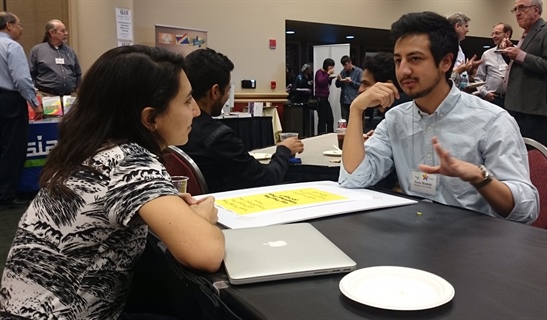Should Your Research Be on YouTube?
This year’s SIAM Conference on CSE featured a new attraction: “SIAM Communication Doctors,” a booth for people wishing to craft effective messages about their research—for communication to future employers, at outreach events, or for the press. Graduate students, postdocs, and faculty visited the booth, hoping that booth doctors could turn their research summaries into good stories that would appeal to the public. At the booth, reporter Flora Lichtman, whose work has appeared in The New York Times and on NPR’s Science Friday, joined conference attendees Nick Higham (University of Manchester), Jeff Humpherys (Brigham Young University), Rachel Levy (Harvey Mudd College), and Matt Parno (Massachusetts Institute of Technology) to offer feedback as people pitched their ideas.
“Having given many talks and workshops on science/math communication, I can tell you SIAM’s communication booth was exceptionally effective,” Lichtman said. “The one-on-one setup meant visitors walked away with communication tips tailored to their particular research. It also gave “doctors” a better sense of some of the challenges researchers face when communicating about their work. A great model.” In an earlier SIAM News article, Levy, Lichtman, and David Hu (Georgia Tech University) offered tips on scientist-reporter collaborations.

“I think one of the biggest things I took away from my conversation at the Communication Doctors booth was the tip to have a few overview pictures, slides or sketches handy to discuss my research in case anyone shows interest,” said David Gleich, an assistant professor of computer science at Purdue University. “What you take for granted as ‘standard knowledge’ is often quite surprising to others.”
Based on the level of interest at the CSE conference, SIAM invites interested readers to submit video clips in which they briefly describe their work and explain why they should be given help to produce a YouTube video communicating the work. The pitch video should answer these or similar questions: What is your topic? Why is it important? Who will benefit from your work? Why do you need help communicating about your research?
Submissions will be judged on prospective content, enthusiasm, and audience. The winner will receive professional advice and coaching on research communication, along with the services of a professional videographer to film and edit the video. To apply, please prepare your video pitch (we hope that, although unprofessional, submissions will be creative and interesting!) and send it to videopitch@siam.org by July 24 (extended deadline!). A winning entry will be selected by the end of August; all coaching and production work will be completed by the end of 2015.
The winning clip will be posted on YouTube on the SIAM channel, included in the “SIAM Presents” pages, and promoted via SIAM’s media distribution lists.
About the Author
Rachel Levy
Professor, North Carolina State University
Rachel Levy is a professor of mathematics and executive director of the Data Science and AI Academy at North Carolina State University.
Stay Up-to-Date with Email Alerts
Sign up for our monthly newsletter and emails about other topics of your choosing.



